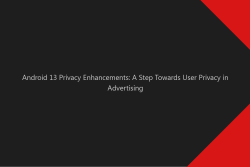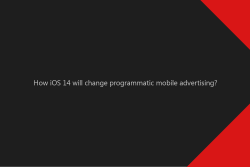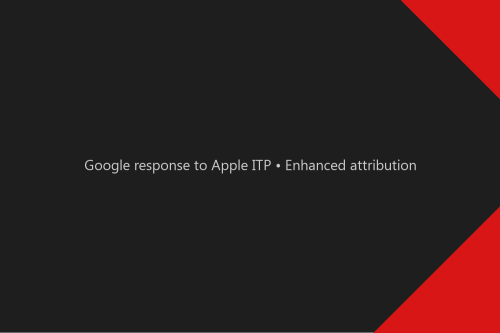Android 13 Privacy Enhancements: A Step Towards User Privacy in Advertising
Android 13 Privacy Features: Safeguarding User Privacy in Advertising Compared to iOS Google’s Android 13 is here, and with it comes many privacy updates to improve user...
Filter by Category
Filter by Author

Android 13 Privacy Features: Safeguarding User Privacy in Advertising Compared to iOS Google’s Android 13 is here, and with it comes many privacy updates to improve user...
Posted by Wojtek Andrzejczak

The United States has seen significant changes in its privacy regulations recently. In 2023, two landmark pieces of legislation, the California Privacy Rights Act (CPRA) and the...
Posted by Wojtek Andrzejczak

In the Cookie-less times, contextual targeting is getting more popular than ever. But are we able to deliver contextual targeting programmatically? What is Contextual targeting?...
Posted by Wojtek Andrzejczak

Since Programmatic Digital-Out-Of-Home (DOOH) is getting more popular, it also brings questions about how we could take an advance it. One of those advantages can be Dynamic...
Posted by Wojtek Andrzejczak

How will the programmatic mobile advertising change after the iOS 14 release? How we’ll be able to run programmatic campaigns? YT#2 – iOS 14 vs. programmatic advertising How...
Posted by Wojtek Andrzejczak
How will the programmatic mobile advertising change after the iOS 14 release? How we’ll be able to run programmatic campaigns?
Contents
Publishers use IDFA and GAID as their primary key elements to identify app users and build custom audience segments based on their app activities. Advertisers can find the shopping app users and show them the personalized ads in other apps or websites.
Google, thanks to the fingerprinting, can find an app user outside of the app. Without IDFA, finding users across the network will not be easy and, for many other publishers, not possible.
But when you sign in the app using, for example, “Sign in with Apple” or you use “Apple Pay,” you could give publishers enough information about the user so they could run the ad business entirely without IDFA. For example, Apple would make an excellent use of those data if they would have their own advertising display network, right? Right.
But what removing IDFA means for clients and media agencies? How exactly will it affect campaign planning and campaign performance?
We need to remember that no one has expected mobile advertising without IDFA in the first place. Well, except Apple, obviously.
Many publisher platforms still use IDFA as a primary user identification for mobile apps. With limited Cookies lifetime on the mobile web, they might lose a lot of potential to deliver personalized ads.
Finding a user on iOS 14 devices might be limited. The apps do not have cookies, and only one unique identifier IDFA will not be available anymore. Publishers might improve this over time by using app instance ID, but each app on the device will have a different ID, unlike IDFA, which was the same for each app on the user device.
The best example of such an approach might be Firebase SDK, which you can implement in the app and on the website. Google is already using his own generated IDs to track users across the app and web environment. Then you could run the retargeting campaigns using Google Ads or DV360 by linking them into the Firebase project.
Some campaign strategies might not work and can underperform significantly. Mostly when we have a Line Item, we don’t do a split between iOS and Android devices. In general, strategies for those two platforms should be identical, but without IDFA, campaign strategy and targeting options for iOS 14 will work differently.
Depending on the platform socio-demographic targeting, affinity, and in-market audiences might not work or be very limited. Frequency Cap should work. But, I’d also be not surprised if it would not work in the first few months after the iOS 14 release.
User retargeting will work if we use the audience collected directly from the app as 1st party data, but only if our custom audience segment does not collect users based on IDFA. Otherwise, the retargeting might have poor results.
Based on the information we have, I’d say that the iOS app monetization will be a problem, and there is a high chance that Android apps will be overbooked. iOS apps will not deliver as many ads as now, so ad revenue will be limited.
At this point, campaigns may have under-delivery because android apps will be overbooked, especially here in Switzerland, where the iOS device market share is over 50%.
Programmatic bookings for iOS might not deliver ad impressions because of the additional selected targeting options. Custom Audience segments created on the publisher side might have some problems, since they mainly rely on the IDFA.
There are many questions and not many answers. But a few things are certain. Apple does not want anybody to track iOS users, and they will do everything to keep it that way. They initiated the death of the 3rd party cookies and then restricted use of the 1st party cookies. Now they killed IDFA, which will have a massive impact on the whole advertising industry. I’m really thinking about what they will come up next year? Maybe, Apple Mobile Advertising SDK, which could be the only way to deliver ads on iOS apps? Who knows.
Thank you for watching, I hope you have enjoyed this video. If you like it, please click on the subscribe button, so you get notified about new videos on this channel. And if you have any questions, please leave a message in the comment section below.
Subscribe to our newsletter!

Google Enhanced attribution is an answer for Apple Intelligent Tracking Prevention (ITP). But how does it actually work?

Since Programmatic Digital-Out-Of-Home (DOOH) is getting more popular, it also brings questions about how we could take an advance it. One of those advantages can be Dynamic...
Nice article. Apple Sucks they care about user privacy but doesn’t care about small developer like me.My Coverage fall to 40% when most of my users updated there devices to iOS 14. Seems like no one clicking on allow tracking.